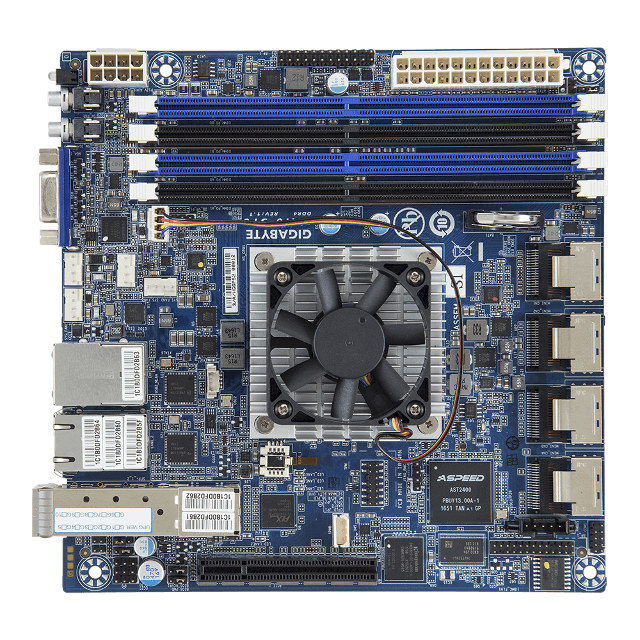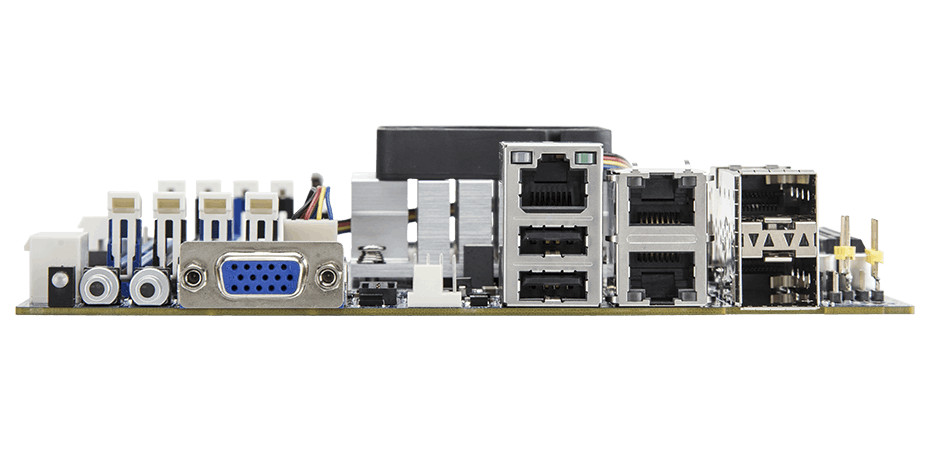Last year, we wrote about Intel Atom C3000 series processor for micro-servers with the post also including some details about MA10-ST0 motherboard. GIGABYTE has finally launched the mini-ITX board with an unannounced Atom C3958 16-core Denverton processor.

GIGABYTE MA10-ST0 server board specifications:
- Processor – Intel Atom C3958 16-core processor @ up to 2.0GHz with 16MB L2 cache (31W TDP)
- System Memory – 4x DDR4 slots for dual channels memory @ 1866/2133/2400 MHz with up to 128GB ECC R-DIMM, up to 64GB for ECC/non-ECC UDIMM
- Storage
- 32GB eMMC flash
- 4x Mini-SAS up to 16 x SATA 6Gb/s ports
- 2x Mini-SAS ports are shared with PCIe x8 slot
- Connectivity
- 2x 10Gb/s SFP+ LAN ports
- 2x 1Gb/s LAN ports (Intel I210-AT)
- 1x 10/100/1000 management LAN
- Video – VGA port up to 1920×1200@60Hz 32bpp; Aspeed AST2400 chipset with 2D Video Graphic Adapter with PCIe bus interface
- USB – 2x USB 2.0 ports
- Expansion Slots – 1x PCIe x8 (Gen3 x8 bus) slot; shared with Mini-SAS ports, Mini_CN2, Mini_CM3
- Misc
- 1x CPU fan header, 4x system fan headers
- 1x TPM header with LPC interface
- 1x Front panel header
- 1x HDD back plane board header
- 1x JTAG BMC header
- 1x Clear CMOS jumper
- 1x IPMB connector
- 1x PMBus connector
- 1x COM (RS-232)
- Power and ID buttons with LEDs; status LED
- Board Management – Aspeed AST2400 management controller; Avocent MergePoint IPMI 2.0 web interface
- Power Supply – 1x 24-pin ATX main power connector; 1x 8-pin ATX 12V power connector
- Dimensions – 170 x 170 mm (Mini-ITX form factor)
- Temperature Range – 10 to 40°C
- Relative Humidity – 8-80% (non-condensing)
The dual core Atom C3338 is the only processor listed on Intel’s formerly Denverton page, with now info about the 16-core Atom C3958 processor so far.

The board is said to support Windows Server 2016, Red Hat Enterprise Linux Server 7.1, SuSE Linux Enterprise Server 12, Ubuntu 14.04.2 LTS, Fedora 22, and CentOS 7.1. The board is sold with an I/O shield and a quick start guide. There’s no word about pricing or availability on the product page, but Anandtech reports that the “board is essentially ready to go, and interested parties should get in contact with their local reps”. For reference, SuperMicro A2SDI-H-TP4F-O board based on the same processor is sold for $820+ on Atacom.

Jean-Luc started CNX Software in 2010 as a part-time endeavor, before quitting his job as a software engineering manager, and starting to write daily news, and reviews full time later in 2011.
Support CNX Software! Donate via cryptocurrencies, become a Patron on Patreon, or purchase goods on Amazon or Aliexpress





16 cores with a 31W TDP… I expect the single-threaded performance to be poor
@Mum
That’s a low power part. There’s been a fair amount of discussion about Denverton performance in an earlier post about a motherboard with the dual core version of the processor @ http://www.cnx-software.com/2017/07/05/supermicro-a2sdi-2c-hln4f-server-mini-itx-motherboard-is-based-on-intel-atom-c3338-denverton-processor/
@Mum Let’s wait and see. Unlike CNX (‘up to 2.0GHz’) product page and Anandtech talk about ‘2.0 GHz base frequency (no word on turbo)’ (the 2 core C3338 is said to operate at 1.5Ghz base frequency and up to 2.2GHz Turbo) so maybe TurboBoost 2.0 will allow single threaded workloads to run at a higher clockspeed while slowing down all cores busy in parallel to a value (way) below those 2.0Ghz above. The C3338 is said to support up to 4 x 2.5GbE which is something I miss here (at least 10GBase-T would’ve been nice to keep the costs down… Read more »
More from Supermicro here – https://www.supermicro.nl/products/motherboard/ATOM/
The C3338 was announced some time ago
Freenas build
i guess it’s avoton inheritor, so should be atom-class cpu, nothing much to expect for single thread performance
@Doktor-x
looks like so
it seems like an odd combination of parts, the possibility of a pair of 20G ports and relatively low end CPU.
the low end C3338 only supports a single memory channel (see below), so hopefully this C3958 will have a lot more memory bandwidth to service all its cores and the I/O.
I think this is targeted at hipsters that need to spend $1000 on something that will use their grandfathers VGA monitor and play DOS games.
I was ready to buy a bunch of them but find the lack of a 3.5″ floppy drive and DB25 printer port disappointing.
😉
@crashoverride While I understand that you try to be funny and want to do some boring PC/Intel bashing (‘How retrograde these interfaces are!’) you should be aware that the VGA port is part of the AST2400 management IC. This is a pretty slow ARM9 SoC providing remote management capabilities and the reason why it’s used so widely is that it also provides display output without the need to buy an additional VGA add-on card (as it was common in the past if you had to deal with hardware/OS combinations that did not support the concept of a serial console —… Read more »
tkaiser : Of course AST2400 is using the only reasonable choice for direct KVM display support: VGA (HDMI/DVI KVM switches can be found on desktops but in rack cabinets people expect to be able to use the same 16/24 port KVM switches they bought 2 decades ago and that obviously means VGA support). And of course these things do support ‘KVM over IP’ but for installation purposes in a rack direct KVM support is a nice feature and VGA support still mandatory. Every other display connector would be an absolute fail for the use case in question. At the risk… Read more »
So I just looked up Denverton – SSSE3 is the highest SIMD ISA Denverton supports. Intel are backpedalling on SIMD in Atoms. For reference, the last SSSE3 part I bought was a 2011 Bobcat.
@tkaiser I completely understand they made it because customers asked for it. The irony is that its part of a larger trend that myself and others see where technology is moving backwards instead of forward (entirely a discussion for a different time). The point is not “PC/Intel” bashing. Rather, its an observation of the now obtuse predicament that “PC” finds itself a part of: “the odd combination of parts”. As further evidence, the origin of an OS typically install on a device such as this will be senior to both the installer and the intended users of it! They will… Read more »
@crashoverride
in fact, consider this board as headless one (no graphics output).
this vga port is only used in combination with the aspeed chip. it allows a sysadmin want to have physical access to the machine, which doesn’t happen often since these boards are usually located in a datacenter and the aspeed chip also allows the said sysadmin to access the board via management LAN.
you could consider this a datacenter uart interface if you want.
@Mum Huh? This is a server board. It can be used for nothing else than server tasks since it lacks direct display output. Those Aspeed BMC thingies like AST2400 here simulate an old/slow PCI[e] graphics card. The main purpose is to grab the framebuffer, encode/compress it and send it to a remote location (KVM over IP). And yeah, there’s also an analog VGA port that mirrors this display (prone to artefacts just like KVM over IP). Using HDMI/DVI/Displayport would be both possible and stupid at the same time since direct display connection will only be used for installation purposes (attach… Read more »
@tkaiser: If you’re using the QAT models and OpenSSL with QAT support enabled then SSL/TLS handshakes are offloaded. The QAT models are intended for network appliances, including VPN servers and proxies. Even without QAT Denverton holds it’s own on OpenSSL benchmarks (there are some in the link I posted in another comment).
The Register files these boards under “Data Centre -> Storage”
See: http://www.theregister.co.uk/2017/08/15/atomic_systems_servers_and_motherboards/
For a low power “atom” based server, the 3955 is shockingly fast on multi-threaded work. I put atom in quotes because it blows the C2750 away and beats the Xeon-D and even a few newer Xeon’s. It’s definitely a niche board but I’m really glad I put off buying a D1541.
https://www.servethehome.com/intel-atom-c3955-16-core-top-end-linux-benchmarks-review/
@blu: source?
Denverton is Goldmont based, which supports largely the same SIMD as Silvermont (SSE4.2 + AES-NI), plus SHA acceleration. I’d say it’s much more likely that your source is incorrect than to say that Denverton supports anything less than SSE4.2.
Denverton has SSE 4.2. It does not have AVX, maybe there was some confusion on which SIMD support was lacking. Some models also have QuickAssist (QAT) which can offload more crypto than AES and/or zlib compression (there are various SKUs with different flavors of QAT).
@Sandbender
Impressive results. Seems one can use zlib compression for storage pools without any doubt and with up to 128GB ECC DRAM dedup on somewhat large zpools becomes possible. Looking forward to see raidz2 benchmarks soon.
@tkaiser
You’ll get the best performance with ZFS on Linux and a QAT board. ZoL 0.7 added QAT support for zlib as well as SSE (and neon on ARM) optimizations of Fletcher4 and RaidZ operations. To my knowledge, ZFS on FreeBSD has little to no hardware acceleration b/c FreeBSD avoids using MMX/SSE in the kernel (to save the overhead of context/state saves). Netgate (pfSense) recently ported QAT to FreeBSD so support for that might be introduced down the road.
Indeed, my source was incorrect – I did a more thorough lookup and SSE4.2 is the correct SSE level for Denverton. Luckily the source got corrected earlier today:
https://en.wikipedia.org/w/index.php?title=List_of_Intel_Atom_microprocessors&type=revision&diff=795663770&oldid=795354408
@blu: Lies, Damn Lies and Wikipedia 😉 The sth link I posted above with benchmarks also has a screenshot of /proc/cpuinfo with the all the feature flags.
@Sandbender
Thanks for the benchmarks, and yes, your link was among the top google hits for Denverton /proc/cpuinfo yesterday ; )
Intel have put the part up on ARK
https://ark.intel.com/products/97927/Intel-Atom-Processor-C3958-16M-Cache-up-to-2_0-GHz
@blu
Just in case there’s any confusion, I don’t have any affiliation with STH. It’s owned/managed by a consultant named Patrick Kennedy.
Hopefully it will be working with Solaris/OpenSolaris.
This MB will be perfect for ZFS.